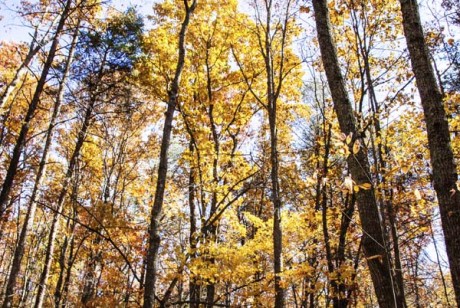Protecting family forests
Good management can improve woodland health and provide an income
By Amy NeyForests provide a number of well-known benefits—protection for fresh water, habitat for wildlife, recreation and beauty, and vital economic products such as lumber and paper. What is not commonly known is who really owns the forest land in our state. According to a 2008 USDA Forest Service publication, "Who Owns America's Forests?", over half of the 751 million acres of forest land in the U.S is privately owned. In North Carolina, 84 percent of the woodland is privately owned, and over half of that is termed "family forests" — an acre or more of land with trees on at least 10 percent of it. To say it another way: nearly 11.2 million acres of forest land in North Carolina is owned by people just like you and me, who own more than an acre, and have trees on at least one-tenth of their property.
Many family forest owners in North Carolina own between one and 19 acres and do not have a management plan. Population growth and development pressure threaten our unique resources and habitats throughout the Southeast. New threats affecting forest health and productivity are emerging, such as fire danger and invasive plant and animal species. Why does this matter? As development in our region continues, it is becoming increasingly important that the diminishing amount of forest land is well managed. The decisions made by each of the forest owners in North Carolina make a collective impact on the health of the state's forests as a whole.
What you should know if you own woodlands
Obviously, your goals for your land determine how you will manage it. You might manage for hunting or timber or wildlife, but you could also manage for all three. Management techniques are not mutually exclusive — a method that enhances the wildlife habitat may also increase the health of the forest and could even provide an income. The forest type on your land, determined by the age and tree species variety, will also affect how you choose to manage your forest.
Thinning
As your forest stand (a group of trees of similar age, composition and general appearance) grows, you might consider some treatments to improve its health and vigor. Thinning removes some trees, decreases competition, can improve wildlife and possibly provide some income. A specific type of thinning is "crop tree release," which removes any tree in direct competition with predetermined trees that the landowner has selected for wildlife, timber or other objectives. Pruning is an intensive method used to remove unnecessary branches and improve the financial value of the timber. Stand improvement involves removing trees that are undesirable because of species, form or condition. A salvage treatment is not planned, but is used to remove trees that have been or are in imminent danger of being killed or damaged, such as by wind, disease, insects, flood or hurricane.
Regeneration
Different regeneration methods may be used on your forest stand depending on its species, size and your goals. Before considering any method of regeneration, make sure you know where your seed source is for the next generation, whether already in the soil or coming from a nearby stand. You might also choose to replant.
Single tree selection harvests specific trees throughout the stand, allowing sunlight to reach the forest floor, creating a stand that is composed of multiple ages of trees. Because leafy branches of trees grow rapidly to block the sunlight, this is not an effective method in the Southern Appalachians.
Group tree selection is similar, but involves removing clusters of trees instead of single trees. But be careful of anyone wanting to harvest your trees by selecting only the larger, healthier, more valuable ones. This is called "high-grading" or a "diameter limit cut." It may provide more income, but it usually degrades the health and the species of the forest by removing the best trees and leaving the inferior ones behind to continue growing.
In a seed tree harvest, two to 12 evenly spaced healthy trees are left in a stand when all the others are harvested. These trees provide seed for the next forest generation, and are removed at a later date.
The "shelterwood" method leaves more trees per acre which provide seed and shelter for the next generation, and is considered more visually appealing. It may require more harvesting entries in the forest and is therefore more labor intensive and expensive.
The "clearcut" method is often opposed, but it is the easiest method to perform because it removes all the trees in a forest stand at the same time. It removes all the undesirable trees, allowing a brand new single-aged forest to emerge, which may be the best option in the mountains. It may look unsightly for awhile, but if it is done properly it does not cause more soil erosion than any of the other methods. Clearcutting can also be done in patches or strips to help ease the visual disturbance.
Publications
"Who Owns America's Forests?" USDA Forest Service Publication NRS-INF-06-08, May 2008. www.nrs.fs.fed.us/pubs/inf/NRS-INF-06-08.pdf
"Woodscaping Your Woodlands" N.C. Cooperative Extension Service Publication AG-584. Prepared by Robert Bardon. www.ces.ncsu.edu/forestry/pdf/ag/ag584.pdf
"Forest Land Enhancement Practices for North Carolina" N.C. Cooperative Extension Service Publication G04-44478. Prepared by Rick A. Hamilton and Mark A. Megalos. www.ces.ncsu.edu/forestry/pdf/flep.pdf
-
Share this story:




